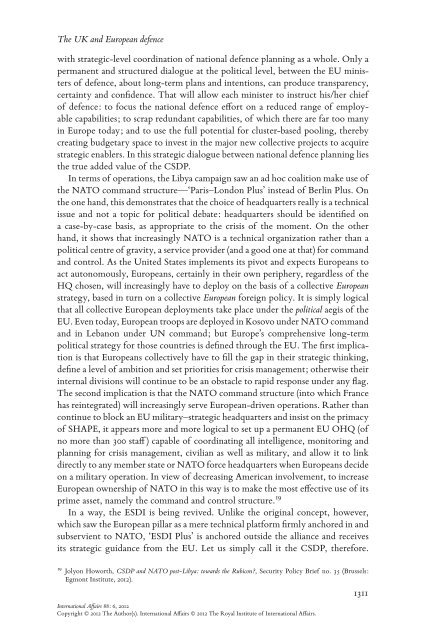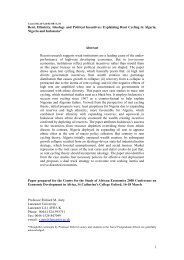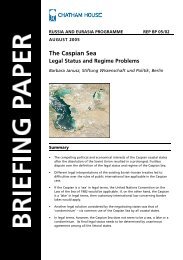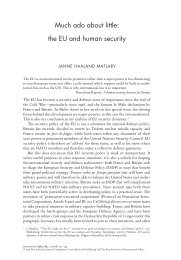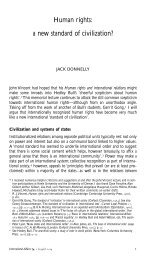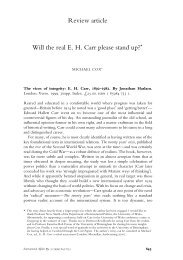The UK and European defence: leading or leaving? - Chatham House
The UK and European defence: leading or leaving? - Chatham House
The UK and European defence: leading or leaving? - Chatham House
You also want an ePaper? Increase the reach of your titles
YUMPU automatically turns print PDFs into web optimized ePapers that Google loves.
<strong>The</strong> <strong>UK</strong> <strong>and</strong> <strong>European</strong> <strong>defence</strong><br />
with strategic-level co<strong>or</strong>dination of national <strong>defence</strong> planning as a whole. Only a<br />
permanent <strong>and</strong> structured dialogue at the political level, between the EU ministers<br />
of <strong>defence</strong>, about long-term plans <strong>and</strong> intentions, can produce transparency,<br />
certainty <strong>and</strong> confidence. That will allow each minister to instruct his/her chief<br />
of <strong>defence</strong>: to focus the national <strong>defence</strong> eff<strong>or</strong>t on a reduced range of employable<br />
capabilities; to scrap redundant capabilities, of which there are far too many<br />
in Europe today; <strong>and</strong> to use the full potential f<strong>or</strong> cluster-based pooling, thereby<br />
creating budgetary space to invest in the maj<strong>or</strong> new collective projects to acquire<br />
strategic enablers. In this strategic dialogue between national <strong>defence</strong> planning lies<br />
the true added value of the CSDP.<br />
In terms of operations, the Libya campaign saw an ad hoc coalition make use of<br />
the NATO comm<strong>and</strong> structure—‘Paris–London Plus’ instead of Berlin Plus. On<br />
the one h<strong>and</strong>, this demonstrates that the choice of headquarters really is a technical<br />
issue <strong>and</strong> not a topic f<strong>or</strong> political debate: headquarters should be identified on<br />
a case-by-case basis, as appropriate to the crisis of the moment. On the other<br />
h<strong>and</strong>, it shows that increasingly NATO is a technical <strong>or</strong>ganization rather than a<br />
political centre of gravity, a service provider (<strong>and</strong> a good one at that) f<strong>or</strong> comm<strong>and</strong><br />
<strong>and</strong> control. As the United States implements its pivot <strong>and</strong> expects <strong>European</strong>s to<br />
act autonomously, <strong>European</strong>s, certainly in their own periphery, regardless of the<br />
HQ chosen, will increasingly have to deploy on the basis of a collective <strong>European</strong><br />
strategy, based in turn on a collective <strong>European</strong> f<strong>or</strong>eign policy. It is simply logical<br />
that all collective <strong>European</strong> deployments take place under the political aegis of the<br />
EU. Even today, <strong>European</strong> troops are deployed in Kosovo under NATO comm<strong>and</strong><br />
<strong>and</strong> in Lebanon under UN comm<strong>and</strong>; but Europe’s comprehensive long-term<br />
political strategy f<strong>or</strong> those countries is defined through the EU. <strong>The</strong> first implication<br />
is that <strong>European</strong>s collectively have to fill the gap in their strategic thinking,<br />
define a level of ambition <strong>and</strong> set pri<strong>or</strong>ities f<strong>or</strong> crisis management; otherwise their<br />
internal divisions will continue to be an obstacle to rapid response under any flag.<br />
<strong>The</strong> second implication is that the NATO comm<strong>and</strong> structure (into which France<br />
has reintegrated) will increasingly serve <strong>European</strong>-driven operations. Rather than<br />
continue to block an EU military–strategic headquarters <strong>and</strong> insist on the primacy<br />
of SHAPE, it appears m<strong>or</strong>e <strong>and</strong> m<strong>or</strong>e logical to set up a permanent EU OHQ (of<br />
no m<strong>or</strong>e than 300 staff ) capable of co<strong>or</strong>dinating all intelligence, monit<strong>or</strong>ing <strong>and</strong><br />
planning f<strong>or</strong> crisis management, civilian as well as military, <strong>and</strong> allow it to link<br />
directly to any member state <strong>or</strong> NATO f<strong>or</strong>ce headquarters when <strong>European</strong>s decide<br />
on a military operation. In view of decreasing American involvement, to increase<br />
<strong>European</strong> ownership of NATO in this way is to make the most effective use of its<br />
prime asset, namely the comm<strong>and</strong> <strong>and</strong> control structure. 19<br />
In a way, the ESDI is being revived. Unlike the <strong>or</strong>iginal concept, however,<br />
which saw the <strong>European</strong> pillar as a mere technical platf<strong>or</strong>m firmly anch<strong>or</strong>ed in <strong>and</strong><br />
subservient to NATO, ‘ESDI Plus’ is anch<strong>or</strong>ed outside the alliance <strong>and</strong> receives<br />
its strategic guidance from the EU. Let us simply call it the CSDP, theref<strong>or</strong>e.<br />
19<br />
Jolyon How<strong>or</strong>th, CSDP <strong>and</strong> NATO post-Libya: towards the Rubicon?, Security Policy Brief no. 35 (Brussels:<br />
Egmont Institute, 2012).<br />
International Affairs 88: 6, 2012<br />
Copyright © 2012 <strong>The</strong> Auth<strong>or</strong>(s). International Affairs © 2012 <strong>The</strong> Royal Institute of International Affairs.<br />
1311


